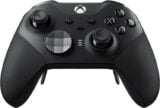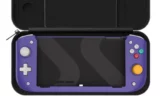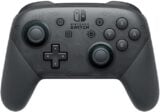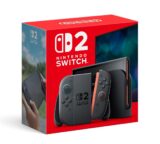The Atari 400 Mini is a fantastic tribute, with one major sticking point
With an eclectic mix of built-in games and support for more via USB, the joystick is the only thing that lets us down

It’s now been around eight years since the NES Classic Edition was released, and the ‘mini system’ trend has continued to roll along ever since.
At this point we’ve now got a shelf full of miniature consoles, computers, handhelds and arcade cabinets, each offering a selection of titles from their respective libraries, usually alongside a recreation of the original controller for authenticity.
One company that leans away from the mini console side of things and focuses more on recreating home computers is UK-based Retro Games, which previously brought us the C64 Mini (followed by a full-sized version with a working keyboard) and the Amiga-based A500 Mini.
Now it’s back, this time with the 400 Mini, a shrunken replica of Atari’s first entry in the home computer market, the Atari 400. And for the most part, it’s done a fantastic job with it.
For those not familiar with this part of gaming history, the Atari 400 and Atari 800 computers were both released on the same day in November 1979, but at nearly half the price the 400 ended up outselling the 800 by around 2 to 1.
Retro Games’ latest offering is a brilliant way to discover its library for the first time, but there’s just one thing we don’t like about it.
The Hardware
The 400 Mini is a wonderfully dinky recreation of Atari’s computer, but like the C64 Mini and A500 Mini before it, its keyboard is only there for show and doesn’t actually work. The same goes for its little cartridge flap at the top, which doesn’t open and is purely decorative.
The device comes with an HDMI cable and a USB power cable which, like most gizmos of its type these days, requires you to provide your own plug. Alternatively, you can plug it into something with a powered USB slot – we plugged it into the front USB port of our Xbox Series X and it powered up without any argument.
Also accompanying the unit is The CX Stick, Retro Games’ recreation of the widely-used Atari CX40 joystick (which was initially included with the Atari 2600 but worked on numerous other systems). This is the single sticking point for us in the overall package.

It’s not without merit – while the original Atari stick had a single fire button and nothing else, The CX Stick includes a bunch of discreetly hidden extra buttons around its circular dial, at the back and even on the corner of the base, allowing each game to map certain keyboard controls to the stick (and preventing you from having to bring up the device’s virtual keyboard each time).
However – and this will likely be down to personal taste – we think The CX Stick feels absolutely awful to use. In terms of authenticity, fair play to it, it’s managed to retain that spongy feeling of the original Atari stick. But even the stick which came with the Atari 2600+ (which we also weren’t a fan of) felt a little more responsive than this one.
Playing Boulder Dash was an exercise in patience, as sometimes while yanking the stick down our character would go down for a bit then move to the side, often resulting in death. Lee (a modified version of the classic platformer Bruce Lee with the licence removed) is similarly infuriating.
What’s more, as we struggled to find a position to hold the joystick so it would respond better to our commands, we kept accidentally pressing the other buttons located around the stick, leading to even more frustration.
Mercifully, this isn’t a complete deal-breaker. Retro Games’ decision to make The CX Stick a USB controller means it can be swapped out for a variety of other third-party controllers. There’s no definitive list on which ones work with it, but we tried a number of controllers and generally had a good success rate.
We attempted to plug in two wired third-party Xbox Series X/S controllers made by Nacon, but both remained completely dead. However, we also tried a cheapo third-party wired Switch controller by PowerA and the brilliant SNES-like SN30 Pro USB controller from 8BitDo and both worked flawlessly, with both the D-Pad and left stick working, letting you choose between either.

Even better, if you still want the retro joystick experience, Retro Games’ own controller The Joystick – which launched alongside the C64 Mini with its own sponginess issues but was reworked into a wonderfully clicky stick and released with its full-sized C64 – also works perfectly with the 400 Mini and is probably our recommended controller for it.
In short, then, we strongly dislike the stick provided with the 400 Mini, but the fact that plenty of other controllers work instead means it’s not a lost cause.
The Interface
The game’s frontend will be familiar to anyone who previously bought the C64 Mini or A500 Mini, because it’s laid out in a similar manner.
The 400 Mini outputs at 720p at either 50Hz or 60Hz, depending on your preference. Retro Games seemingly made the device with the UK in mind, so it recommends that players activate 50Hz mode if their TV supports it.
The 25 built-in games are introduced with the same carousel-style layout you’ll have seen in numerous mini systems by now, with Retro Games correctly deciding that there’s no point in fixing what isn’t broken.

Each game is represented by its original box art, a large screenshot and some blurb explaining what it’s all about.
There are also four save slots for each game, meaning you can save your progress during play should you ever deem it necessary. You can also rewind mid-game by up to 30 seconds, if you mess up and want to try that last bit again.
Display options are fairly rudimentary, offering 4:3 or pixel-perfect aspect ratios (the former looks more like it did on TV, the latter reduces the on-screen shimmering it creates), and an optional CRT filter. Other than the option to apply a border design around the screen, that’s about it. It serves the purpose it needs to, however.
The Games
The 400 Mini comes with 25 games built-in, covering the general lifespan of the Atari 400 and 800.
There’s a decent selection in here, from ports of Atari arcade favourites like Asteroids, BattleZone, Centipede and Missile Command, to other gems like Bruce Lee (renamed Lee here), Boulder Dash, Miner 2049er and Hover Bovver (which recently featured in Digital Eclipse’s Jeff Minter compilation).
Naturally, the Atari 400 and 800 didn’t sell anywhere near as something like the NES, SNES or Mega Drive, so the games here stand less of a chance of catering to a player’s nostalgia glands. However, the titles chosen here give an interesting and varied representation of the Atari 400 and 800 catalogue, meaning those with any interest in retro gaming history will have a great time discovering them.
The full list of games on offer here is:
- Airball
- Asteroids
- Basketball
- BattleZone
- Berzerk
- Boulder Dash
- Bristles
- Capture the Flag
- Centipede
- Crystal Castles
- Elektraglide
- Encounter!
- Flip and Flop
- Henry’s House
- Hover Bovver
- Lee
- M.U.L.E.
- Millipede
- Miner 2049er
- Missile Command
- O’Riley’s Mine
- The Seven Cities of Gold
- Star Raiders II
- Wavy Navy
- Yoomp!
25 games will only get you so far, however, especially when thousands of games were released for Atari computers. That’s where the game’s USB stick support comes into play. This supports ROM files (which Retro Games insists you have to acquire legally, more to protect itself than anything), meaning you can greatly expand the number of games you can play on it.
In fact, the 400 Mini’s emulation lets you load games for not only the Atari 400 and 800, but also the 130XE, 800XL and the Atari 5200 console, and supports 12 different file extensions so wherever you ‘acquire’ your games there’s a good chance they’ll work.

Since these games weren’t included with the 400 Mini as standard, some of them will require keyboard inputs. You can either bring up a virtual keyboard by hitting the Home and Menu buttons at the same time, or you can just plug a USB keyboard into one of the controller ports and use that too.
We tried a variety of games on the 400 Mini and they all worked perfectly fine. You can even load multi-disk games by selecting numerous disks at the same time, then pressing a button combination to swap disks while playing.
We almost wish its Atari 5200 support was accompanied by support for the Atari 2600 and 7800, because the inability to load games from USB was a major drawback of the recently released Atari 2600+ console.
The Verdict
The Atari 400 may not have been the top of most players’ wishlists for miniaturised game systems, but that’s actually one of the reasons it’s such a worthwhile purchase.
Getting a mini NES, SNES or Mega Drive is all well and good, but it’s well-trodden territory and many of the games on those systems are available on other services. They’re fantastic for nostalgia, of course, but they’re not exactly deep cuts (the Mega Drive Mini 2 aside).
The Atari 400 will obviously have that nostalgic appeal to a percentage of its audience who owned one back in the day, but for others it’s a brilliant introduction to a part of gaming history that’s maybe not visited as frequently as systems from Nintendo, Sega or the like (or even Atari’s consoles).
The selection of games on offer has been really well curated to provide a solid representation of what the Atari 400 and 800 were capable of, but the ability to add your own games via USB – something that so many other mini systems (try to) prevent – really elevates it.
The only main issue is the joystick, which we couldn’t like any less if we tried, but the fact this can be remedied with something like a £20 PowerA Switch controller (or Retro Games’ own, infinitely better £30 micro switch C64 joystick) means it’s an issue that’s easily remedied.
Joystick aside, then, the result is a mini system that may not immediately be considered a must-have among those not too familiar with it, but one that we strongly recommend to anyone keen to expand their retro gaming knowledge. Atari 400 fans will obviously want it regardless, but even if you’re not among its previous clientele, there’s no better way to discover its worth.
The Atari 400 may not be one of the most popular systems in gaming history, but that's exactly why the 400 Mini is such a brilliant addition to the mini system collection. Its provided games brilliantly sum up what the computer was capable of, and the USB support makes thousands of extra games playable too. Just bear in mind that you might want to swap the joystick out for something more responsive: sometimes authenticity can be a downside.
- A brilliantly curated selection of interesting games
- USB ROM support is hugely welcome
- Outer case is an excellent recreation of the original hardware
- Supports a bunch of other USB controllers...
- ...which is useful, because we really don't like the joystick
















